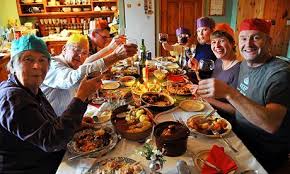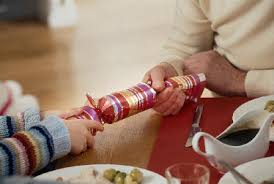DOWNLOAD THE ENTIRE DECEMBER 2016 NEWSLETTER including this month’s Freebie.
 This season brings varied and complex emotions: joy and nostalgia, love and loneliness. New research helps to explain how these feelings affect us—with some practical implications for making the season brighter and more meaningful.
This season brings varied and complex emotions: joy and nostalgia, love and loneliness. New research helps to explain how these feelings affect us—with some practical implications for making the season brighter and more meaningful.
Embrace the Nostalgia:The bittersweet emotion increases feelings of vitality
On holidays, it’s natural to feel a longing for times gone by—a childhood spent singing carols or meals spent with now departed loved ones. Recently scientists have explored the bitter-sweet feeling of nostalgia, finding that it serves a positive function, improving mood and possibly mental health.
A new paper illuminates why it works, finding that this loningly sentimental feeling does not cement us in the past but actually raises our spirit and vitality.
In several experiments conducted online and in the laboratory, when subjects were induced to experience wistful reverie via sentimental song lyrics or memories, they reported greater self-continuity, as measured by a validated index that asks participants how much they agree with statements such as “I feel connected with my past” and “important aspects of my personality remain the same over time.” Constantine Sedikides, a psychologist at the University of Southampton (England) and the main author of the paper, which was recently published in Emotion, had shown this effect in a 2015 paper. But here they found that nostalgia boosted self-continuity by increasing a sense of social connectedness. Sentimental recollections often include loved ones, which can remind us of a social web that extends across people—and across time.
 The researchers found this pattern in American, British and Chinese participants. They also went a step further and observed, via questionnaires about other concurrent feelings, that self-continuity brings a feeling of vitality—of “energy and spirit.”
The researchers found this pattern in American, British and Chinese participants. They also went a step further and observed, via questionnaires about other concurrent feelings, that self-continuity brings a feeling of vitality—of “energy and spirit.”
Tim Wildschut, one of Sedikides’s Southampton collaborators on the paper, notes there are many ways people elicit nostalgia—looking at photographs, cooking certain meals, sharing stories or playing music. He calls the feeling, which we naturally experience several times a week, “a psychological immune response that is triggered when you experience little bumps in the road.” So if you are feeling a bit undone over the holidays, pull out a photo album and spend some time revisiting your past.
The Christmastime Suicide Myth: Rates are low before, on and after Christmas, but New Year’s Day sees a spike
It seems logical that for a depressed person, the holidays might be especially tough—extra stress, loneliness and sad reminders of lost loved ones—so perhaps the popular belief that suicides spike around Christmastime is no surprise. Yet the data tell a different story. Recent studies from several countries show that rates in December and on Christmas in particular tend to be the lowest of the year, but other major holidays do see spikes, especially New Year’s Day.
In one such study, suicide rates in England consistently dipped on Christmas and spiked on New Year’s Day during the 15-year study period, according to the paper published in June in the Journal of Affective Disorders. The researchers reported an overall peak in springtime, and the highest daily rates were observed on Mondays. An older study reported a similar Christmas Day decline in the U.S., with rates up to 15 percent lower than average on that day.
Findings reported in 2015 in the European Journal of Public Health concur, showing about 25 percent fewer suicides around Christmas-time in Austria. Rates there were particularly low on Christmas Eve and remained so until January 1, when the most suicides of any day of the year occurred. The authors also observed higher rates on Mondays and  Tuesdays, as well as during the week after Easter.
Tuesdays, as well as during the week after Easter.
There are exceptions to this trend. Australia and Mexico do see slightly elevated rates on both Christmas Day and New Year’s Day (as well as on Mother’s Day and Mexican Independence Day). But most nations follow the myth-busting pattern: suicide rates are lower than average around Christmas.
According to clinical psychologist Martin Ploderl, a co-author of the Austrian study, there is typically more social connection for many people around Christmas, which is an established protective factor for suicide. Psychiatric hospital admissions also decrease during this period.
So why the spike on New Year’s? Researchers suggest “the broken promise effect” may explain it—along with the increases after Easter and weekends. Many of us are familiar with the feeling after holidays: ‘Was that it? I expected more fun, more relaxation, and tomorrow I have to go back to everyday life….For depressed people, the broken promise of Christmas and the blank year lying ahead may increase hopelessness and thus suicide risk. The greater alcohol consumption that takes place on New Year’s Eve and Day may also play a role in lowering inhibitions, and some people may postpone their planned suicide so that their families and friends can enjoy Christmas (yes, honestly!).
The More Rituals the Merrier: Family traditions of any type boost enjoyment of gatherings
Some people go home for the holidays hoping just to survive, burying their attention in their phones or football to avoid conflict with relatives. Yet research now suggests that is the wrong idea. Family rituals— of any form— can save a holiday, making it well worth the effort of getting everyone in the same room.
 In a series of studies published in the Journal of the Association for Consumer Research, hundreds of online subjects described rituals they performed with their families during Christmas, New Year’s Day and Easter, from tree decoration to egg hunts. Those who said they performed collective rituals, compared with those who said they did not, felt closer to their families, which made the holidays more interesting, which in turn made them more enjoyable. Most surprising, the types of rituals they described—family dinners with special foods, religious ceremonies, watching the ball drop in Times Square—did not have a direct bearing on enjoyment. But the number of rituals did. Apparently having family rituals makes the holidays better and the more the merrier.
In a series of studies published in the Journal of the Association for Consumer Research, hundreds of online subjects described rituals they performed with their families during Christmas, New Year’s Day and Easter, from tree decoration to egg hunts. Those who said they performed collective rituals, compared with those who said they did not, felt closer to their families, which made the holidays more interesting, which in turn made them more enjoyable. Most surprising, the types of rituals they described—family dinners with special foods, religious ceremonies, watching the ball drop in Times Square—did not have a direct bearing on enjoyment. But the number of rituals did. Apparently having family rituals makes the holidays better and the more the merrier.
The study could measure only correlations between subjects’ responses, leaving causality uncertain—Do rituals increase holiday pleasure, or do people who already enjoy the holidays choose to perform more rituals? Yet enjoyment ratings were higher when given after, versus before, describing rituals, suggesting that simply thinking about rituals can put a warm and fluffy filter on one’s experience.
Whatever the ritual is, and however small it may seem, it does appear to help people get closer to one another. Some participants reported that with some rituals they didn’t even know why they did them, but they still seemed to work.
 It could be that rituals offer “small, nonobvious ways” to get people to share an experience without feeling awkward or forced. Compare that with “obvious ploys” such as saying, “Hey, everyone, it’s time to watch The Queen’s Speech”….which might be more likely to produce a whole lot of resistance.
It could be that rituals offer “small, nonobvious ways” to get people to share an experience without feeling awkward or forced. Compare that with “obvious ploys” such as saying, “Hey, everyone, it’s time to watch The Queen’s Speech”….which might be more likely to produce a whole lot of resistance.
So wherever you are at Christmas, and whoever you are spending it with, I hope that you have a wonderful and memorable time. May the coming year bring you health, fulfilment and happiness, and may your dreams keep on coming true.
See you back here again in January 2017!
